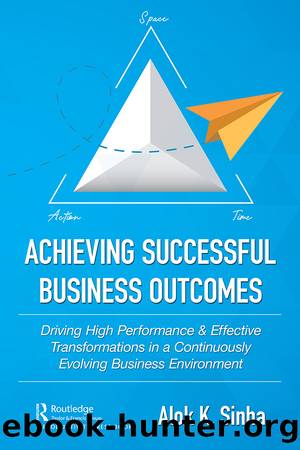Achieving Successful Business Outcomes by Alok K. Sinha

Author:Alok K. Sinha
Language: eng
Format: epub
ISBN: 9781000041729
Publisher: Taylor and Francis
Published: 2020-11-15T00:00:00+00:00
5.4 The Digital Ecosystem â A Self-Sustaining Ecosystem?
All living organisms live in a habitat. Plants and animals together with non-living elements form an ecosystem. Not only landforms and air are non-living, but every living being too becomes non-living after its death. Plants are called producers as they produce food, animals including humans are called consumers as they consume food (herbivores eat plants while carnivores eat plants and animals); fungi and bacteria are called decomposers as they get their food from the dead and the decaying and converting them into minerals and nutrients that goes back into the soil to be consumed by the plants again. There are scavengers too who feed on the dead thus removing carcasses from the earthâs surface and act faster than the decomposers. This food chain operates ceaselessly with the process of eating and being eaten â and maintaining a balance with no alarming excess of any single type in the ecosystem. Food chains are not only stand-alone but interconnected too and the network of such interconnected food chains is known as the food web.
Just like the universe is an ecosystem based on the food chain, the digital network is an ecosystem that is based on the information chain. Food implies energy and the food-chain energy flow; the food chain hence traces the energy pathway from the original source â the sun, to food producers (photosynthesis) to consumers and then the decomposers. Likewise, information is predicated on data and the information chain on the dataflow; the information chain traces its pathway from the originating data sources. The worldwide digital ecosystem is based on data creation and consumption. While the former (till not too long ago), had been limited to deliberate actions (i.e., data related to location, food, medicines, examination results, travel, portals, etc.), found their way to the worldwide digital ecosystem with a reason, the consumption of this data was in the form of information (or knowledge, via analysis) primarily for making informed decisions or transacting within the social, business or personal boundaries â again, all very purposeful and voluntary. With the advent of the digital ecosystem, as more and more devices are getting on the Internet, data creation is fast becoming an involuntary act. Devices are generating data related to non-living objects (cars, buildings, energy consumption, traffic, environmental conditions, etc.) as well as for living beings (health parameters, location, calories consumed, wellness, etc.) and can be consumed by making âconnectionsâ out of this data (e.g., choice of route based on traffic conditions). Hence consumption too is now becoming an involuntary act â which means data that seemingly looks disparate may have many known and unknown connections and, when found, can help drive âoptimumâ decision-making, reducing the ambiguous and the unknown. Automation, greater connectivity, big data storage, analytics, human-machine coordination and access to intelligent information by all will continue to drive this momentum.
A simple example like the digital boarding pass app always has up-to-date, current, continuously relevant data. If the flight is delayed the app automatically
Download
This site does not store any files on its server. We only index and link to content provided by other sites. Please contact the content providers to delete copyright contents if any and email us, we'll remove relevant links or contents immediately.
Time Management Made Easy: How to Cultivate New Habits, Improve Productivity and Get Things Done by Joshua Strachan(2384)
The 7 Habits of Highly Effective People by Stephen R. Covey & Sean Covey(2189)
The Concise Laws of Human Nature by Robert Greene(1782)
Doesn't Hurt to Ask by Trey Gowdy(1589)
Primal Leadership by Daniel Goleman(1200)
Hook Point: How to Stand Out in a 3-Second World by Brendan Kane(1149)
HBR's 10 Must Reads 2021 by unknow(1065)
Don't Sweat the Small Stuff...and It's All Small Stuff by Richard Carlson(1058)
Amazon Unbound by Brad Stone(1000)
100 Things Successful People Do by Nigel Cumberland(984)
HBR's 10 Must Reads 2021 by Harvard Business Review(974)
Master of One by Jordan Raynor(960)
The Job Closer by Steve Dalton(960)
Lives of the Stoics by Ryan Holiday & Stephen Hanselman(923)
Declutter Your Mind: A step by step guide to learn to control your thoughts, stop worrying, relieve anxiety and eliminate panic attacks and negative thinking by Mia Chandler(911)
The Power of 100! by Shaun King(894)
Conflicted by Ian Leslie(827)
Coders at Work: Reflections on the craft of programming by Peter Seibel(810)
The Book of Hope by Jane Goodall(790)
